Telling Cotoneasters apart

My recent botanical illustration work for a Field Studies Chart (as yet unpublished) on Invasive species included 5 species of Cotoneaster.
Telling these plants apart can be a real headache, but I’m going to give it a go, and share my thoughts. I’m more than happy to be corrected in the comments section below!
Cotoneasters are really common, They’re a mainstay of municipal planting and can be found in car parks, round council offices, as well as in people’s gardens. I found 4 different species in Hay on Wye town car park, very convenient! That’s nothing though, there are over 100 species which are routinely used in the UK for ornamental and landscape planting. No wonder telling them apart can be troublesome.
They’re low-growing shrubs with shiny leaves and distinctive red berries. They have no thorns, and the margins of the leaves are smooth and un-toothed. Leaves grow alternately. Flowers are white or pale pink, have five petals, and grow in small clusters.
These plants are invasive species because they can take over native habitats, such as limestone cliffs (Wall cotoneaster) and heathland. They can form thickets which shade out native species. Some of the displaced species are really quite rare. The seeds of Cotoneasters are viable, so may be spread by birds. Many species are becoming natuaralised across a wide range of habitats.
It should be noted that cotoneaster berries can be toxic to humans.
Below are five species of this ubiquitous plant, alongside their tell-tale species traits.

Entire-leaved Cotoneaster, C. integrifolius
Wall Cotoneaster C. horizontalis
Wall cotoneaster is probably one of the commonest species. It’s grown as hedges, and attracts swathes of pollinators when flowering. The growth habit is very distinctive, lateral branches come off a central woody stem and are more or less parallel to one another. It’s a herring-bone pattern that’s clear at any time of year.
Leaves are shiny on top and almost hairless below. They have a distinct murconate or pointed tip. The hairs which are present are sparse and large. They’re 0.6 – 1.2cm long.
Flowers are pink, have white anthers are solitary.
Berries are orange red, shiny, with a puckered 5-pointed scar. They’re borne on very short stalks.
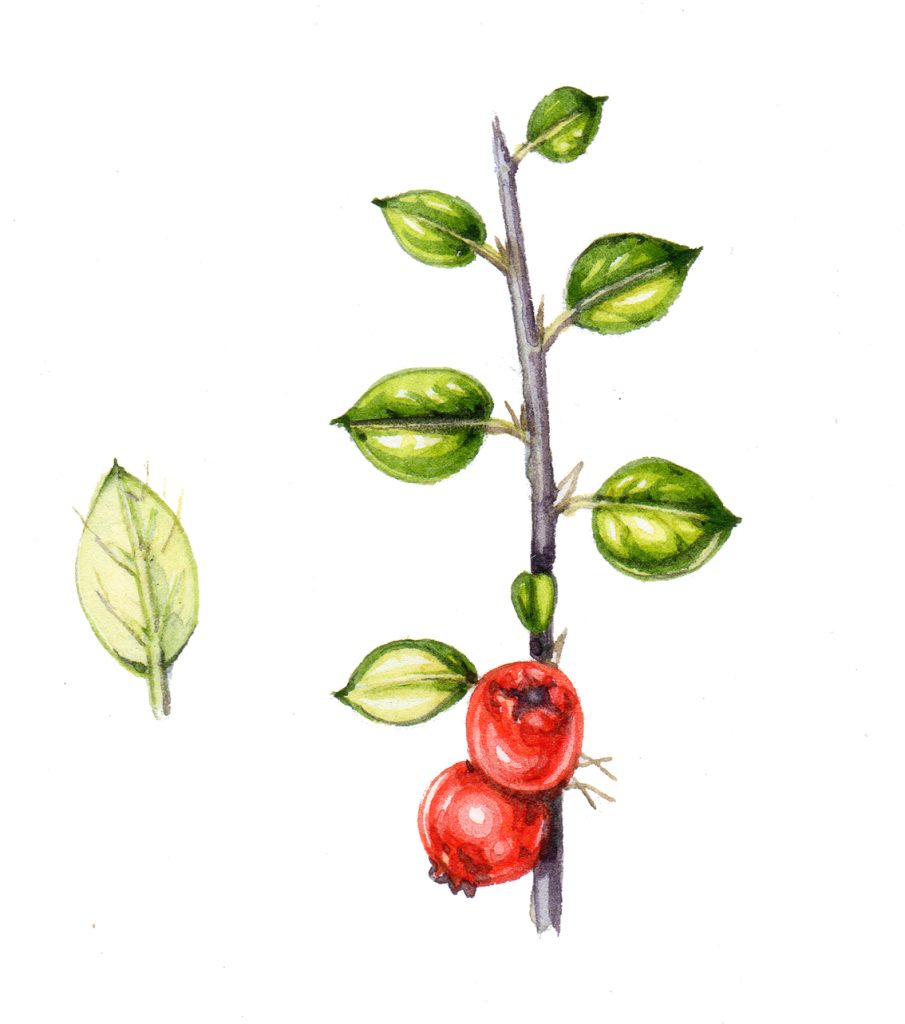
Himalayan Cotoneaster C. simonsii
This species grows as an erect shrub, with deciduous leaves.
The leaves are oval and shiny green on top. They’re 1.5 – 3 cm long, and the underside bears a scattering of hairs. They sometimes look like they have a pale margin.
Flowers are pink and in clusters of up to four flowers. Anthers are white.
The berry is orange-red and rather oblong or ovoid. These fruits are 8-11 mm long and borne in clusters of 4 to 10 berries. They have 2-3 mm long stalks. The literature seems to be in some disagreement about whether or not the berries have hairs at the top and base of the berries. I left them off my illustration.
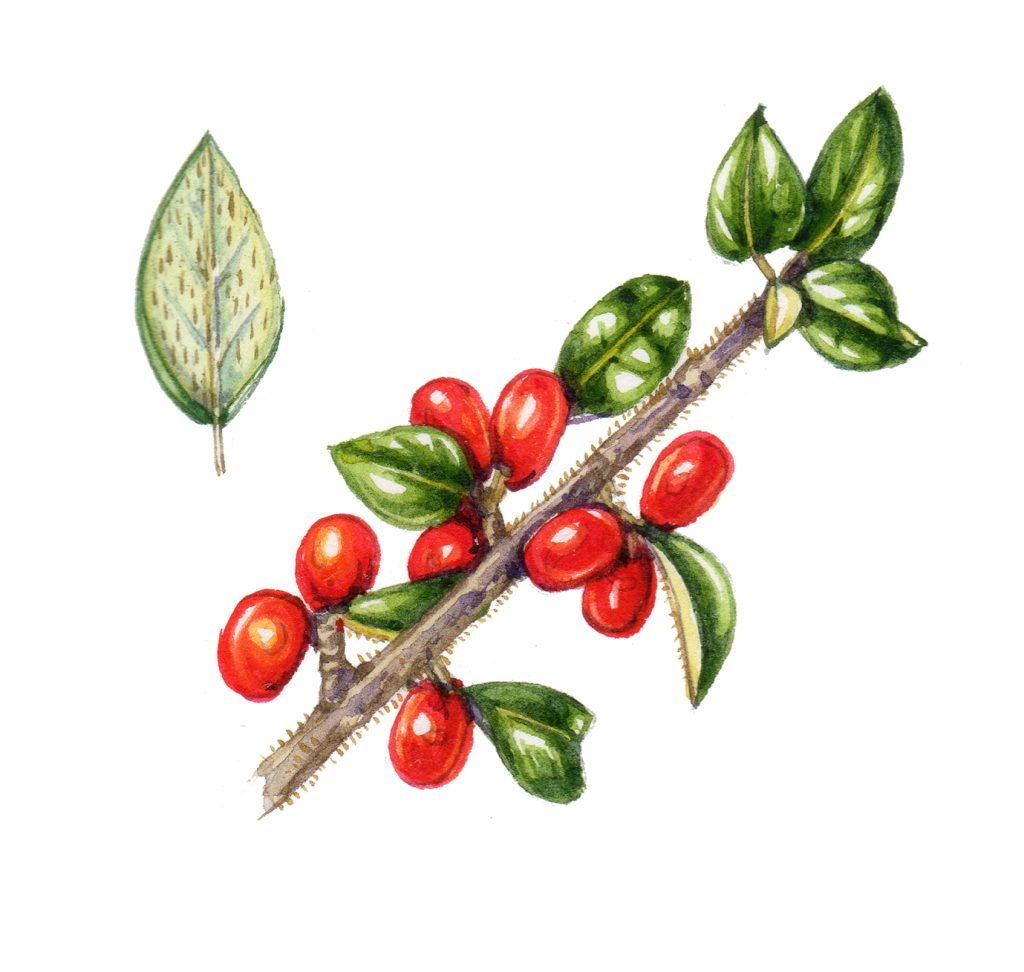
Small-leaved Cotoneaster C. microphyllus
This is another common one. It grows in low-lying evergreen shrubs, and spreads.
The leaves are glossy above, with felted hairy undersides. They’re white-grey below, and the hairs grow parallel to the surface.
Pink flowers grow in groups of us to 5. They can be told apart from other Cotoneasters because the anthers are purple or black.
Berries are scarlet or crimson and spheres of 5-9 mm. They appear singly or in pairs, on short stalks of 2 mm or less.
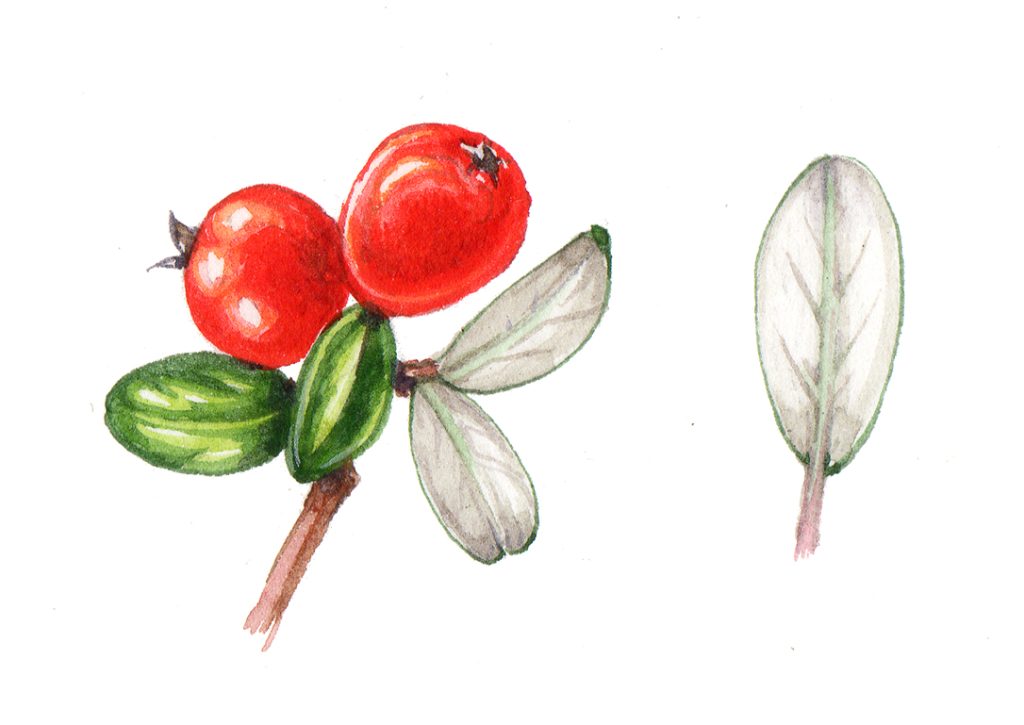
Hollyberry Cotoneaster C. bullatus
Hollyberry Cotoneaster is a large, deciduous shrub.
Leaves are rather different from other species. They’re larger (50 – 128 mm), and have distinctive indented and deep veins. Unlike other species, they’re a matte green on top. The underside of the leaf is paler and has hairs along the central vein.
The flowers are small, and pale pink. They may look deeper pink in bud. They’re are borne in clusters of up to 20 flowers. Anthers are white.
Berries colour readily to a vivid red, and are slightly squared. They’re bigger than in many other species, 8.5–10.5 mm. These are borne in clusters of up to 10 berries, and have a clear stalk. On close inspection, the berries are slightly hairy at the top and on the stalk.
(Info on this species comes mainly from the Flora of New Zealand site)
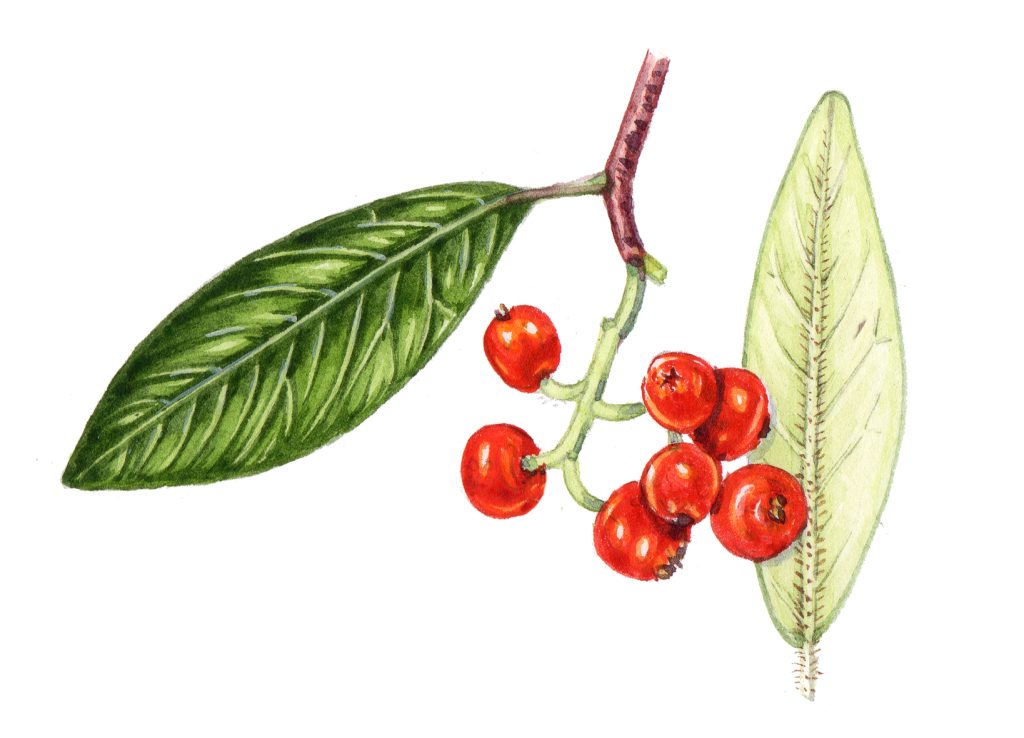
Entire-leaved Cotoneaster C. integrifolius
This plant grows in a markedly prostrate and spreading way, flattened in planes that can cover walls. It’s an evergreen, and you’ll see its berries and dark green leaves through the winter.
Leaves are a glossy dark green, and tend to widen above the middle. They’re often folded, and their length is greater than 2x the width. The leaves are tightly crowded along the branch, each one is 12–25 mm long. They often grow in distinctive rosettes, and have stalks of no more than 2.5mm long. The underside is hairy or wooly, and pale.; hairs are short, stiff and lie close to the leaf surface.
Flowers are white and borne singly. They have red or purplish anthers.
The berries are a give-away with this species. Not only are they very round, but they’re matte. A lovely crimson shade, with no bright shine makes them distinctive. They almost have a bloom on them. They’re 7-9 mm in size.
Can you tell that this is the species I did most work with? It was such a relief to find a species I felt certain about to illustrate!
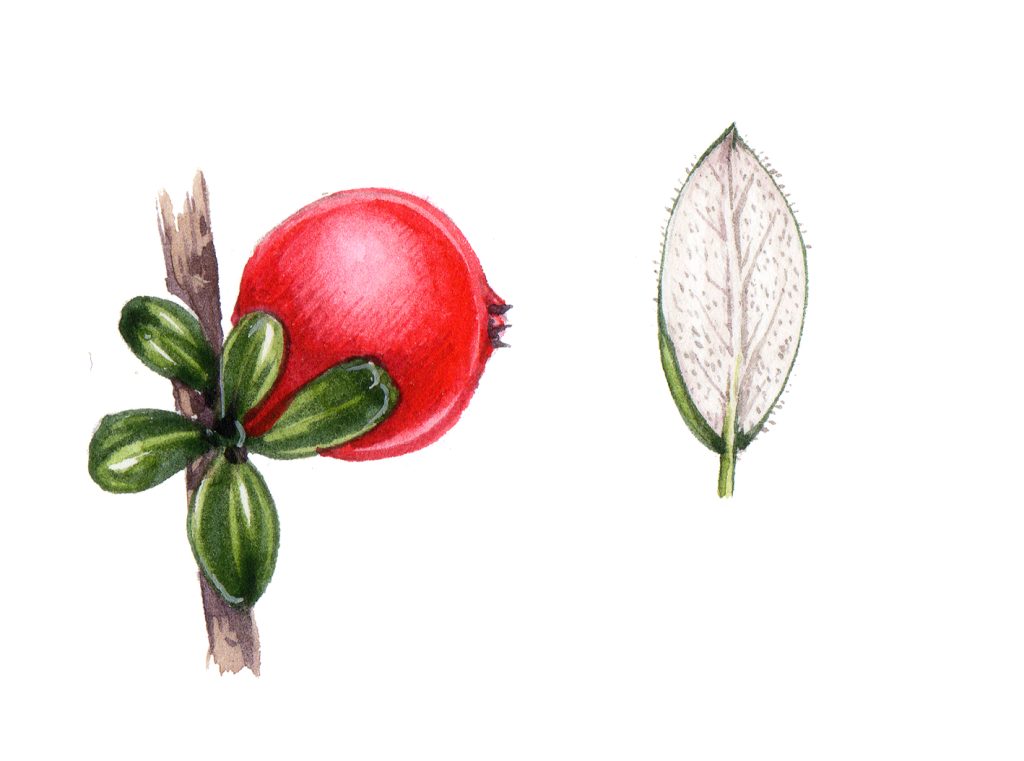
Conclusion
I hope this rather heavy-handed comparison helps you to tell some of these species apart. Add to the confusion the fact thet Cotoneasters seem to hybridize sometimes, and it;s a real mix. Now I definitely feel confident about the herring bone Wall cotoneaster, and the matte-berried Enitre-leaved cotoneaster. So I’ll probably be sticking to those two for now!
My main source of reference for this blog is The Field Guide to Invasive Plants and Animals in Britain by Olaf Booy, Max Wade, and Helen Roy. It’s a great book, if a little depressing. The RHS also has information on different Cotoneasters, with an eye for the garden. The Flora of New Zealand website is very good on the botanical details of the different cotoneasters. However, the definitive work on Cotoneasters is the BSBI plant crib. It can be a little turgid, however, and I found it tricky to see clear differences between species in some cases (probably because I’m not a botanist).
For a few more of my blogs on telling species apart, take a look at my webpage.


Hello Lizzie l remember watching you painting at Hay festival a while ago and loved it, unbeknown to me one of my friends and work colleagues Jo Glover had spent time with you when she was studying natural history illustration and has followed in your style, I am about to go a course in Ludlow with Katy Alston to try to pick up some skills on natural history illustration with hopefully some botanical elements which I prefer, watching your demo was most helpful and I now know the type of pencil & brush to buy to add to my Windsor & Newton paints . Thankyou it will soon be time to come for annual visit to the festival where I usually pick out your mum in the audiences.
Hi Gill! How lovely that you know Jo! She came and worked with me for a week, waaay back. I love seeing her flourish as an illustrator, she’s great. Adele Nozedar (She of The Hedgerow Handbook, Foraging with Kids and The Garden Forager) and I are doing soem kids events at Hay Festival this year, I think it’s on June 2nd. Swing by if you’ve got time to kill and say hi. I’m so flattered that my demo helped, and might have proved useful. Yes, the brush is particularly important. Where would I be without my trusty W&N number 1? I love that you spot Mum in the audience; since she moved to Hay four years ago she goes along to EVERYTHING. She’s as much a part of festival as the newspaper roses and the (inevitable) rain. Thanks so much for the comment.
Hi Lizzie, I’m trying to return a riverbank to natural planting and we have an overgrowth of what I believe to be cotoneaster – I have had trouble identifying it though because in 3 years I have not seen it flower or produce berries eventhough there are many vigorous mature plants which are spreading by layering. Have you seen this before? Also any thoughts on non-herbicide eradication….. I live in West Wales
Hi Paul. I shared you enquiry on Twitter, and although noone flagged up the Cotoneaster they siuggested the followiung as good recovery plants for rivers: Brambles. Grasses, Willowherb. Meadowsweet. Bistort. Im not sure if any of that will be news to you, apologies. You could also take photos of your plant and tweet to @BSBIbotany for a definite identification – Ive not heard of it being into aquatic habitats before, but then Im no expert on the ecology side of these plants, I just paint ’em! Thanks for the comment and if any more info comes in from twitter Ill pass it on. Yours Lizzie